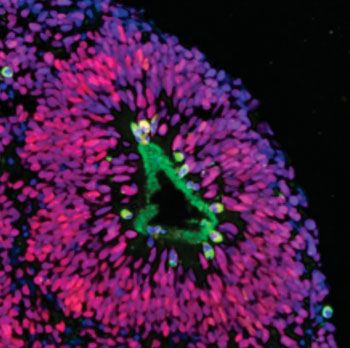Spherical Cell Cultures May Revolutionize the Study of Living Brain Tissues
By LabMedica International staff writers
Posted on 10 Jun 2015
Spherical cultures of neural-type cells generated from human induced pluripotent stem cells (iPS cells) may represent a major breakthrough in the pursuit of a model system for studying living, organized human brain tissue.Posted on 10 Jun 2015
Techniques that allow reprogramming of somatic cells into pluripotent cells that can be differentiated in vitro provide a unique opportunity to study normal and abnormal corticogenesis (development of the brain's cerebral cortex).

Image: A cross section of a human cortical spheroid shows dividing neural progenitor cells (green) against a background of non-dividing neural cells (red) (Photo courtesy of the Pasca laboratory, Stanford University).
In a paper published in the May 25, 2015, online edition of the journal Nature Methods, investigators at Stanford University (Palo Alto, CA) described a simple and reproducible three-dimensional culture approach for generating a laminated cerebral cortex–like structure from pluripotent stem cells that they called human cortical spheroids (hCSs).
To produce hCSs, the investigators created seven batches of iPS cells, from patches of skin obtained from five people. They grew the iPS cells into flat, multicellular colonies on the surface of laboratory dishes. Intact colonies were detached and transferred into special laboratory dishes treated to prevent the cells from adhering to the plastic. Within a few hours, the colonies began to fold upon themselves to create spheres. The young spherical colonies were treated with a combination of growth factors and small molecules to promote their development into neural progenitor cells. After about seven weeks, nearly 80% of the cells in the spheres expressed a protein made by neural tissue, and a further 7% of the cells expressed another protein specifically made by astrocytes. The spheroids grew to be as large as five millimeters in diameter and could be maintained in the laboratory for nine months or more.
Analysis revealed that the spheroids contained neurons from both deep and superficial cortical layers and mimicked in vivo fetal brain development. The neurons were electro-physiologically mature, displayed spontaneous activity, were surrounded by inert astrocytes, and formed functional synapses. Experiments on hCS slices demonstrated that cortical neurons participated in network activity and produced complex synaptic events.
“I am a neurobiologist,” said senior author Dr. Sergiu Pasca, assistant professor of psychiatry and behavioral sciences at Stanford University. “I need to study neurons that are firing. One of the major problems in understanding mental disorders is that we cannot directly access the human brain. These spheroids closely resemble the three-dimensional architecture of the cortex and have gene-expression patterns that mimic those in a developing fetal brain.”
“In contrast to monolayer cultures, we observed an orderly, three-dimensional arrangement of specific types of neuronal cells in the hCSs,” said Dr. Pasca. “Astrocytes are really essential to neuronal signaling, but it has been challenging to efficiently make both neurons and astrocytes at the same time. Until now, researchers have been relying on astrocytes from rodents or human fetal tissue, and trying to grow neurons on top of them. Our system generates astrocytes that develop in concert with and are genetically identical to the surrounding neurons.”
Related Links:
Stanford University








 (3) (1).png)





